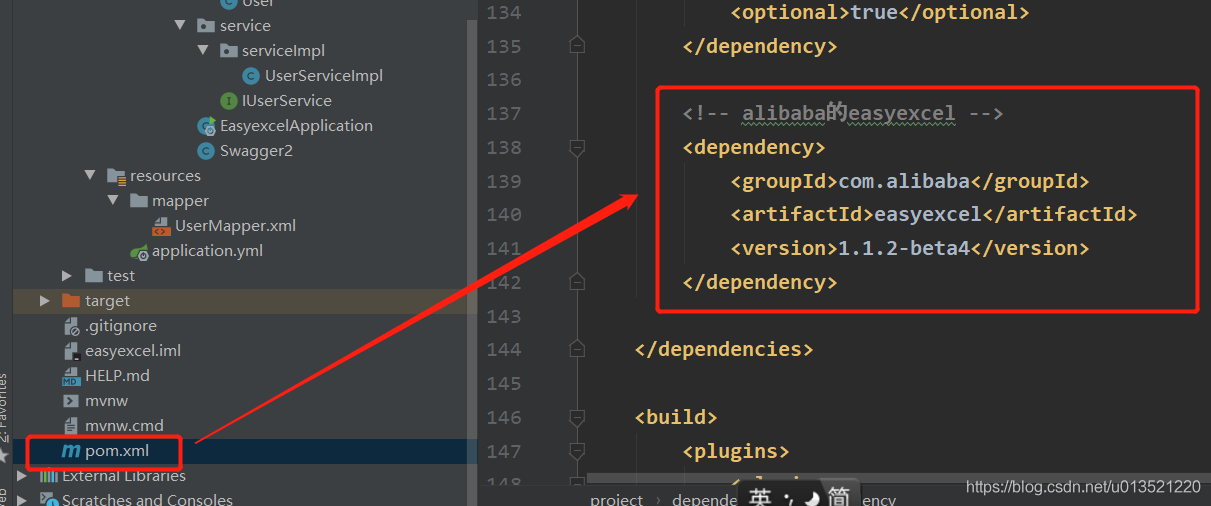easyexcel是阿里巴巴旗下开源项目,主要用于Excel文件的导入和导出处理,今天我们利用SpringBoot和easyexcel实战演示如何导出和写入Excel文件。一、加入我们需要的easyexcel依赖

我们项目还用了其他依赖,我把我的pom文件全部贴在下面,读者自行根据需要取舍
<?xml version="1.0" encoding="UTF-8"?> <project xmlns="http://maven.apache.org/POM/4.0.0" xmlns:xsi="http://www.w3.org/2001/XMLSchema-instance" xsi:schemaLocation="http://maven.apache.org/POM/4.0.0 https://maven.apache.org/xsd/maven-4.0.0.xsd"> <modelVersion>4.0.0</modelVersion> <parent> <groupId>org.springframework.boot</groupId> <artifactId>spring-boot-starter-parent</artifactId> <version>2.2.3.RELEASE</version> <relativePath/> <!-- lookup parent from repository --> </parent> <groupId>com.xu</groupId> <artifactId>easyexcel</artifactId> <version>0.0.1-SNAPSHOT</version> <name>easyexcel</name> <description>Demo project for Spring Boot</description> <properties> <project.build.sourceEncoding>UTF-8</project.build.sourceEncoding> <project.reporting.outputEncoding>UTF-8</project.reporting.outputEncoding> <java.version>1.8</java.version> <swagger-ui.version>2.9.2</swagger-ui.version> <swagger2.version>2.9.2</swagger2.version> </properties> <dependencies> <!-- spring-boot --> <dependency> <groupId>org.springframework.boot</groupId> <artifactId>spring-boot-starter-web</artifactId> </dependency> <!-- log related --> <dependency> <!-- exclude掉spring-boot的默认log配置 --> <groupId>org.springframework.boot</groupId> <artifactId>spring-boot-starter</artifactId> </dependency> <dependency> <groupId>org.springframework.boot</groupId> <artifactId>spring-boot-starter-test</artifactId> <scope>test</scope> </dependency> <dependency> <groupId>junit</groupId> <artifactId>junit</artifactId> <version>4.12</version> <!-- 表示开发的时候引入,发布的时候不会加载此包 --> <scope>test</scope> </dependency> <!-- mybatis-plus begin --> <!--mybatis-plus自动的维护了mybatis以及mybatis-spring的依赖,在springboot中这三者不能同时的出现,避免版本的冲突,表示:跳进过这个坑--> <dependency> <groupId>com.baomidou</groupId> <artifactId>mybatis-plus-boot-starter</artifactId> <version>3.1.0</version> </dependency> <!--swagger2--> <dependency> <groupId>io.springfox</groupId> <artifactId>springfox-swagger-ui</artifactId> <version>${swagger-ui.version}</version> </dependency> <!--排除并新增1.5swagger-annotations和swagger-models 为了解决swagger2中example注解导致的input空字符串异常错误--> <dependency> <groupId>io.springfox</groupId> <artifactId>springfox-swagger2</artifactId> <version>${swagger2.version}</version> <exclusions> <exclusion> <groupId>io.swagger</groupId> <artifactId>swagger-annotations</artifactId> </exclusion> <exclusion> <groupId>io.swagger</groupId> <artifactId>swagger-models</artifactId> </exclusion> </exclusions> </dependency> <dependency> <groupId>io.swagger</groupId> <artifactId>swagger-annotations</artifactId> <version>1.5.21</version> </dependency> <dependency> <